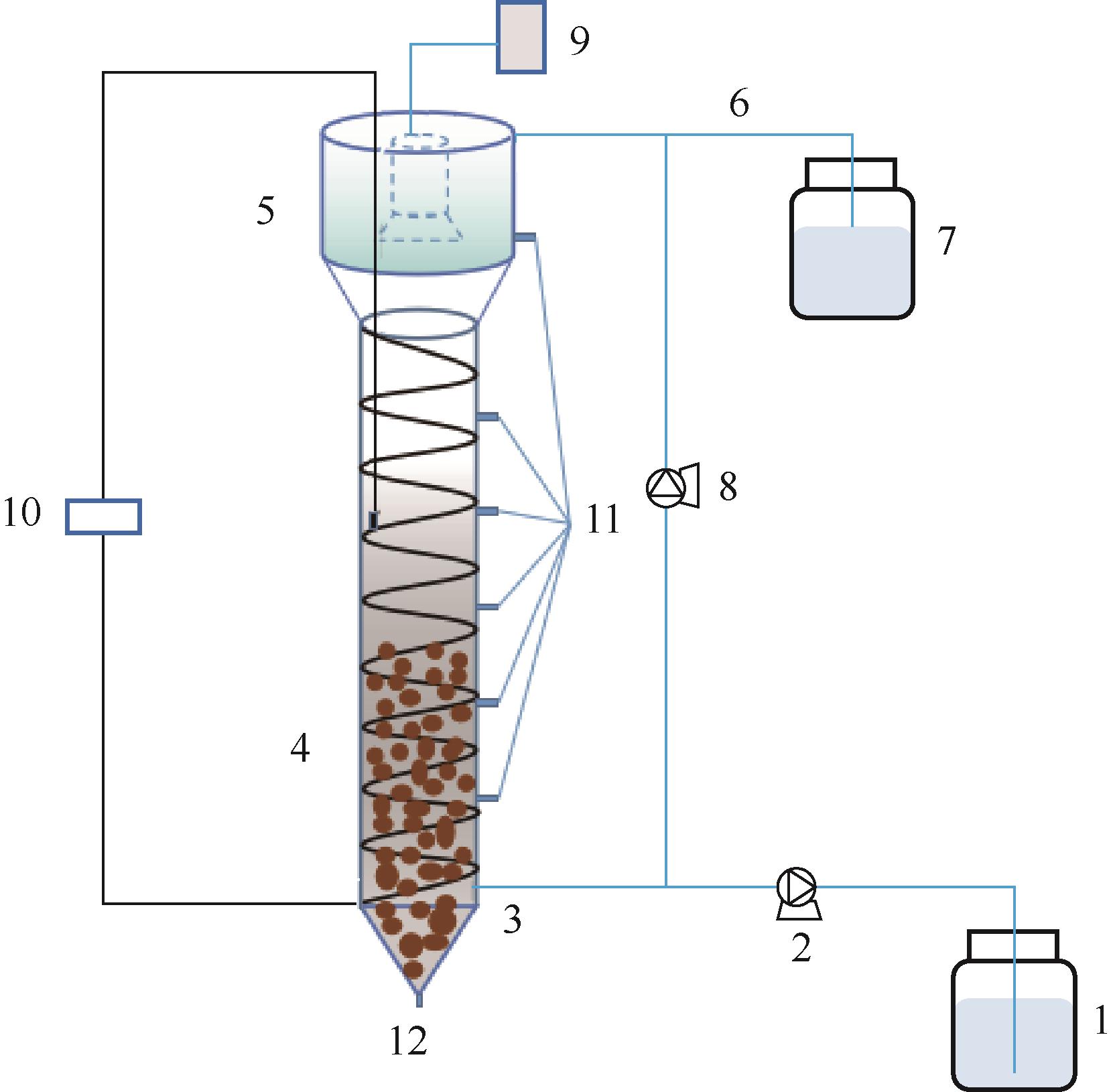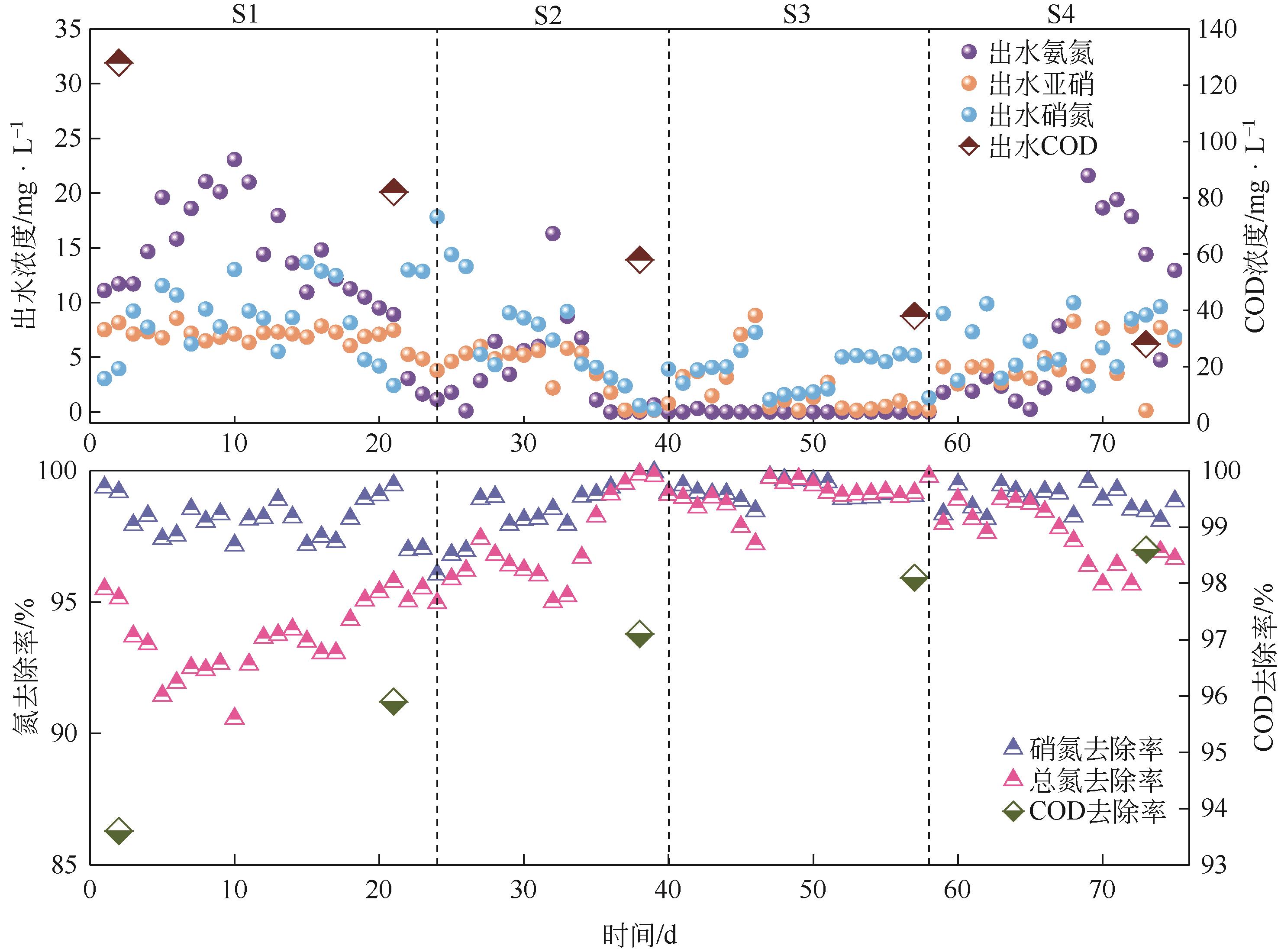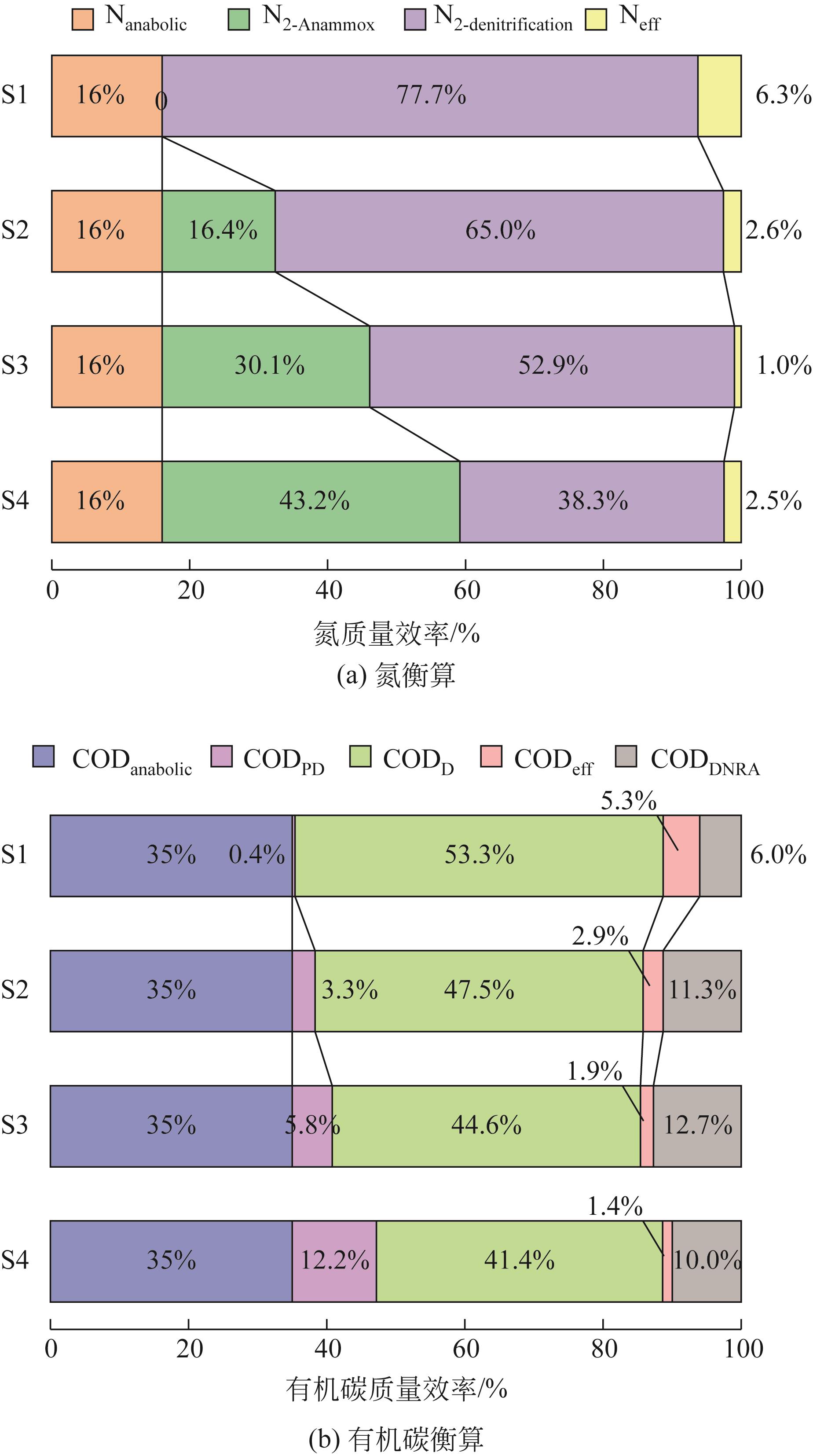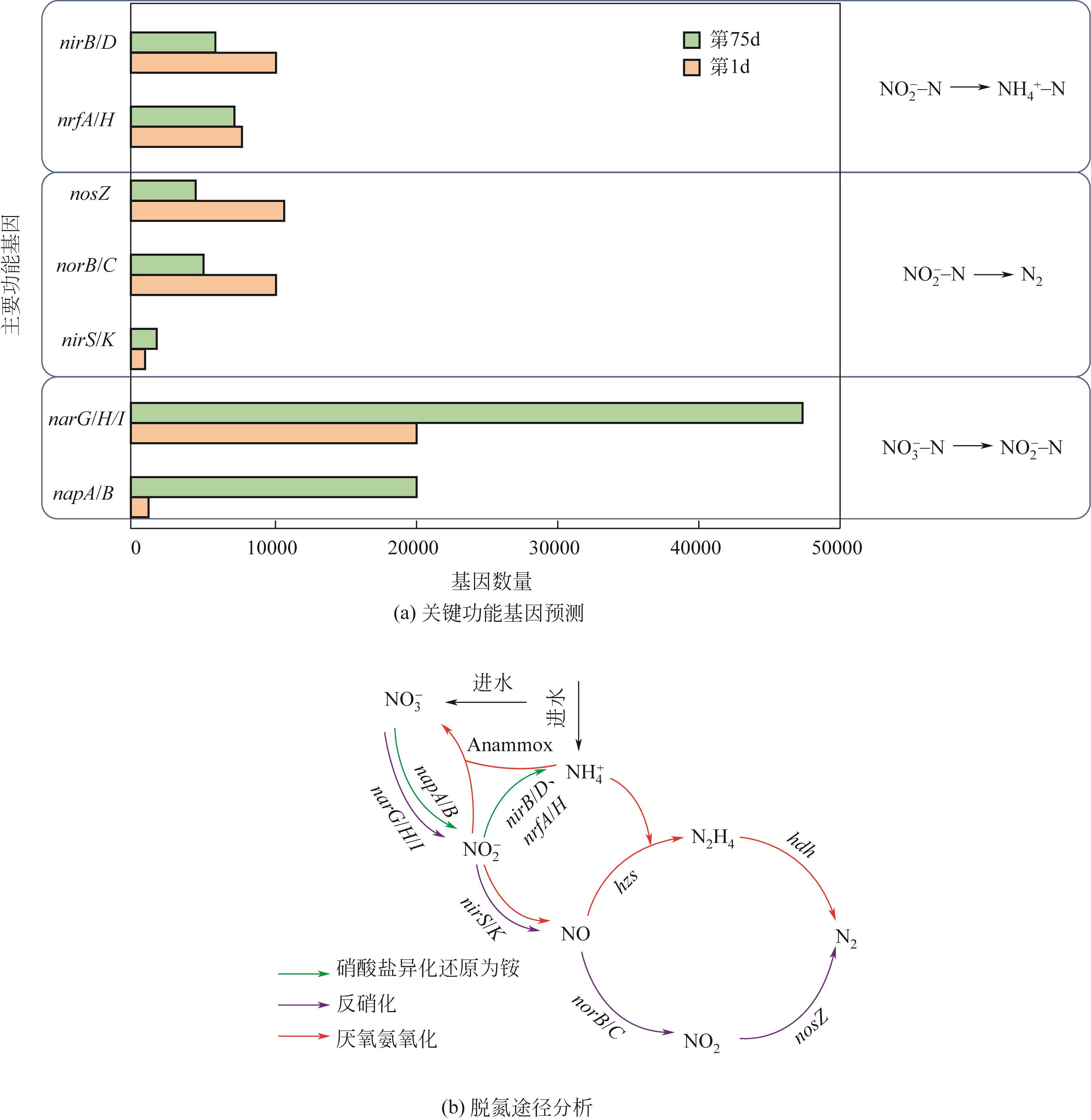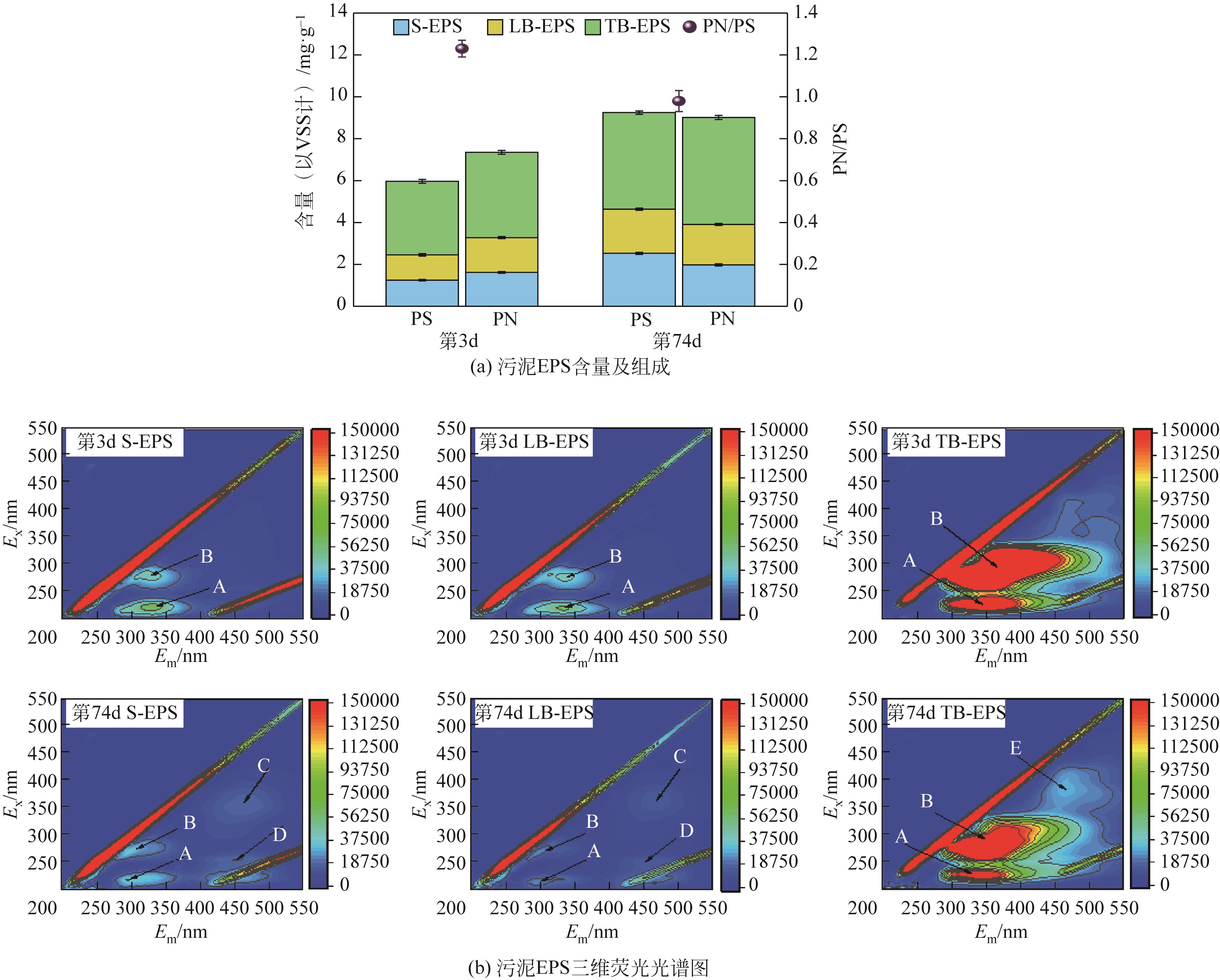化工进展 ›› 2024, Vol. 43 ›› Issue (3): 1593-1605.DOI: 10.16085/j.issn.1000-6613.2023-0449
• 资源与环境化工 • 上一篇
废水处理硝酸盐异化还原与厌氧氨氧化/反硝化耦合工艺构建
- 1.太原理工大学环境科学与工程学院,山西 晋中 030600
2.山西省市政工程研究生教育创新中心,山西 晋中 030600
-
收稿日期:2023-03-23修回日期:2023-05-12出版日期:2024-03-10发布日期:2024-04-11 -
通讯作者:周鑫 -
作者简介:赵瑞强(1997—),男,硕士研究生,研究方向为厌氧氨氧化技术。E-mail:1149366753@qq.com。 -
基金资助:国家自然科学基金(21607111);山西省基础研究计划(20210302123198)
Construction of a coupled process integrating dissimilatory nitrate reduction and anaerobic ammonia oxidation/denitrification for wastewater treatment
ZHAO Ruiqiang1,2( ), ZHOU Xin1,2(
), ZHOU Xin1,2( ), NIU Bingxin1,2
), NIU Bingxin1,2
- 1.College of Environmental Science and Engineering, Taiyuan University of Technology, Jinzhong 030600, Shanxi, China
2.Innovation Center for Postgraduate Education in Municipal Engineering of Shanxi, Jinzhong 030600, Shanxi, China
-
Received:2023-03-23Revised:2023-05-12Online:2024-03-10Published:2024-04-11 -
Contact:ZHOU Xin
摘要:
采用厌氧膨胀颗粒污泥床反应器(EGSB)处理含COD、氨氮和硝氮的模拟废水,旨在高浓度有机废水处理系统中快速构建厌氧氨氧化(Anammox)运行工艺。通过接种少量Anammox污泥和逐步提高氨氮浓度的操作方式,在连续运行58d后,系统成功启动Anammox反应,此时的总氮和COD去除率稳定在97%和98%以上。物料衡算显示,Anammox反应途径对氮的去除贡献逐渐增加,硝酸盐异化还原(DNRA)耦合Anammox和反硝化共同促进了系统的同步脱氮除碳。对微生物群落分析发现,Candidatus Kuenenia相对丰度由0.27%快速升高至35.87%,DNRA菌(Ignavibacterium、Thermogutta)及反硝化菌(Azospira、Gp3)在体系内共存。通过基因注释法,检测出了Anammox、DNRA、硝酸盐还原及亚硝酸盐还原关键基因。运行过程中,颗粒污泥颜色变红且粒径增大;胞外聚合物(EPS)分析表明多糖(PS)和蛋白质(PN)含量增加而PN/PS下降;三维荧光光谱发现腐殖酸类物质增多。研究结果为高浓度有机含氮废水高效处理提供了一种新的工艺途径。
中图分类号:
引用本文
赵瑞强, 周鑫, 牛冰心. 废水处理硝酸盐异化还原与厌氧氨氧化/反硝化耦合工艺构建[J]. 化工进展, 2024, 43(3): 1593-1605.
ZHAO Ruiqiang, ZHOU Xin, NIU Bingxin. Construction of a coupled process integrating dissimilatory nitrate reduction and anaerobic ammonia oxidation/denitrification for wastewater treatment[J]. Chemical Industry and Engineering Progress, 2024, 43(3): 1593-1605.
| 阶段 | 时间/d | COD/mg·L-1 | NO | NH | 总氮进水负荷/kg N·m-3·d-1 | COD进水负荷/kg COD·m-3·d-1 | HRT/d | C/N |
|---|---|---|---|---|---|---|---|---|
| S1 | 1~24 | 2000 | 500 | 0 | 0.25 | 1.0 | 2 | 4.0 |
| S2 | 25~40 | 2000 | 500 | 50 | 0.27 | 1.0 | 2 | 3.6 |
| S3 | 41~58 | 2000 | 500 | 100 | 0.30 | 1.0 | 2 | 3.3 |
| S4 | 59~75 | 2000 | 500 | 200 | 0.35 | 1.0 | 2 | 2.8 |
表1 运行阶段及运行条件
| 阶段 | 时间/d | COD/mg·L-1 | NO | NH | 总氮进水负荷/kg N·m-3·d-1 | COD进水负荷/kg COD·m-3·d-1 | HRT/d | C/N |
|---|---|---|---|---|---|---|---|---|
| S1 | 1~24 | 2000 | 500 | 0 | 0.25 | 1.0 | 2 | 4.0 |
| S2 | 25~40 | 2000 | 500 | 50 | 0.27 | 1.0 | 2 | 3.6 |
| S3 | 41~58 | 2000 | 500 | 100 | 0.30 | 1.0 | 2 | 3.3 |
| S4 | 59~75 | 2000 | 500 | 200 | 0.35 | 1.0 | 2 | 2.8 |
| 阶段 | 出水 | TN去除负荷/kg·m-3·d-1 | TN去除率/% | COD去除率/% | ||
|---|---|---|---|---|---|---|
| NH | NO | NO | ||||
| S1 | 13.3±5.8 | 6.9±1.0 | 9.0±3.8 | 0.22±0.01 | 93.7±1.4 | 94.8 |
| S2 | 3.7±4.3 | 3.6±2.2 | 6.1±4.0 | 0.25±0.01 | 97.3±1.6 | 97.1 |
| S3 | 0.0 | 2.0±2.4 | 3.7±1.8 | 0.29±0.01 | 99.0±0.6 | 98.1 |
| S4 | 8.0±7.4 | 4.6±2.2 | 6.4±2.5 | 0.34±0.01 | 97.3±1.2 | 98.6 |
表2 反应器出水浓度、去除负荷及去除率
| 阶段 | 出水 | TN去除负荷/kg·m-3·d-1 | TN去除率/% | COD去除率/% | ||
|---|---|---|---|---|---|---|
| NH | NO | NO | ||||
| S1 | 13.3±5.8 | 6.9±1.0 | 9.0±3.8 | 0.22±0.01 | 93.7±1.4 | 94.8 |
| S2 | 3.7±4.3 | 3.6±2.2 | 6.1±4.0 | 0.25±0.01 | 97.3±1.6 | 97.1 |
| S3 | 0.0 | 2.0±2.4 | 3.7±1.8 | 0.29±0.01 | 99.0±0.6 | 98.1 |
| S4 | 8.0±7.4 | 4.6±2.2 | 6.4±2.5 | 0.34±0.01 | 97.3±1.2 | 98.6 |
| 反应器 | 主要反应 | 进水COD浓度 /mg·L-1 | C/N | 进水氮类型 | TN进水负荷 /kg·m-3·d-1 | TN去除负荷 /kg·m-3·d-1 | TN去除率 /% | 参考 文献 |
|---|---|---|---|---|---|---|---|---|
| EGSB | DNRA、Anammox、反硝化 | 2000 | 2.8 | NH | 0.35 | 0.34 | 97.3 | 本研究 |
| UASB | PD/A | 102 | 1.7 | NH | 0.96 | 0.79 | 82.3 | [ |
| UASB | PD/A | 210 | 2 | NH | 0.50 | 0.45 | 90 | [ |
| SBR | SAD | 150 | 0.625 | NH | 0.72 | 0.65 | 86.7 | [ |
| nMBR | DNRA、Anammox、反硝化 | 850 | 10 | NO | 0.24 | 0.10 | 40 | [ |
表3 不同Anammox工艺效能比较
| 反应器 | 主要反应 | 进水COD浓度 /mg·L-1 | C/N | 进水氮类型 | TN进水负荷 /kg·m-3·d-1 | TN去除负荷 /kg·m-3·d-1 | TN去除率 /% | 参考 文献 |
|---|---|---|---|---|---|---|---|---|
| EGSB | DNRA、Anammox、反硝化 | 2000 | 2.8 | NH | 0.35 | 0.34 | 97.3 | 本研究 |
| UASB | PD/A | 102 | 1.7 | NH | 0.96 | 0.79 | 82.3 | [ |
| UASB | PD/A | 210 | 2 | NH | 0.50 | 0.45 | 90 | [ |
| SBR | SAD | 150 | 0.625 | NH | 0.72 | 0.65 | 86.7 | [ |
| nMBR | DNRA、Anammox、反硝化 | 850 | 10 | NO | 0.24 | 0.10 | 40 | [ |
| 反应器 | 接种污泥 | 培养方式 | 进水氮源 | 最高总氮去除率/% | 启动时间/d | 参考文献 |
|---|---|---|---|---|---|---|
| EGSB | 厌氧颗粒污泥、5%厌氧氨氧化污泥 | 有机添加 | NH | 99.0±0.6 | 58 | 本研究 |
| UASB | 厌氧氨氧化污泥和活性污泥,体积比1∶2 | 无机添加 | NH | 87.60 | 90 | [ |
| EGSB | 厌氧颗粒污泥 | 无机添加 | NH | 83 | 93 | [ |
| 好氧活性污泥 | 无机添加 | 81 | 63 | |||
| ABBR | 好氧活性污泥 | 无机添加 | NH | >70 | 47 | [ |
| UASB | 混合活性污泥 | 无机添加 | NH | 98 | 85 | [ |
| MBR | 混合活性污泥 | 无机添加 | NH | >90 | 59 | [ |
| ASBR | 恶臭沉积物 | 无机添加 | NH | 53.7 | 60 | [ |
表4 不同Anammox工艺启动对比
| 反应器 | 接种污泥 | 培养方式 | 进水氮源 | 最高总氮去除率/% | 启动时间/d | 参考文献 |
|---|---|---|---|---|---|---|
| EGSB | 厌氧颗粒污泥、5%厌氧氨氧化污泥 | 有机添加 | NH | 99.0±0.6 | 58 | 本研究 |
| UASB | 厌氧氨氧化污泥和活性污泥,体积比1∶2 | 无机添加 | NH | 87.60 | 90 | [ |
| EGSB | 厌氧颗粒污泥 | 无机添加 | NH | 83 | 93 | [ |
| 好氧活性污泥 | 无机添加 | 81 | 63 | |||
| ABBR | 好氧活性污泥 | 无机添加 | NH | >70 | 47 | [ |
| UASB | 混合活性污泥 | 无机添加 | NH | 98 | 85 | [ |
| MBR | 混合活性污泥 | 无机添加 | NH | >90 | 59 | [ |
| ASBR | 恶臭沉积物 | 无机添加 | NH | 53.7 | 60 | [ |
| EPS | 阶段 | A峰 | B峰 | C峰 | D峰 | E峰 | |||||
|---|---|---|---|---|---|---|---|---|---|---|---|
(Ex/Em) /(nm/nm) | 荧光强度 | (Ex/Em) /(nm/nm) | 荧光强度 | (Ex/Em) /(nm/nm) | 荧光强度 | (Ex/Em) /(nm/nm) | 荧光强度 | (Ex/Em) /(nm/nm) | 荧光强度 | ||
| S-EPS | S1 | 222/330 | 64983 | 282/315 | 44313 | 354/460 | 18571 | 256/460 | 19266 | ||
| S4 | 218/295 | 40230 | 270/300 | 36790 | |||||||
| LB-EPS | S1 | 220/335 | 59948 | 278/335 | 41359 | 362/460 | 14143 | 254/460 | 14757 | ||
| S4 | 216/295 | 23497 | 272/300 | 24818 | |||||||
| TB-EPS | S1 | 226/345 | 326406 | 286/350 | 750172 | 382/465 | 30047 | ||||
| S4 | 226/345 | 214944 | 284/345 | 472846 | |||||||
表5 EPS三维荧光参数
| EPS | 阶段 | A峰 | B峰 | C峰 | D峰 | E峰 | |||||
|---|---|---|---|---|---|---|---|---|---|---|---|
(Ex/Em) /(nm/nm) | 荧光强度 | (Ex/Em) /(nm/nm) | 荧光强度 | (Ex/Em) /(nm/nm) | 荧光强度 | (Ex/Em) /(nm/nm) | 荧光强度 | (Ex/Em) /(nm/nm) | 荧光强度 | ||
| S-EPS | S1 | 222/330 | 64983 | 282/315 | 44313 | 354/460 | 18571 | 256/460 | 19266 | ||
| S4 | 218/295 | 40230 | 270/300 | 36790 | |||||||
| LB-EPS | S1 | 220/335 | 59948 | 278/335 | 41359 | 362/460 | 14143 | 254/460 | 14757 | ||
| S4 | 216/295 | 23497 | 272/300 | 24818 | |||||||
| TB-EPS | S1 | 226/345 | 326406 | 286/350 | 750172 | 382/465 | 30047 | ||||
| S4 | 226/345 | 214944 | 284/345 | 472846 | |||||||
| 33 | LI Jia, ZHANG Liang, LIU Jie, et al. Investigation of the phenomenon and influencing factor of partial denitrification in anoxic zone of a municipal wastewater treatment plant[J]. Acta Scientiae Circumstantiae, 2021, 41(1): 109-117. |
| 34 | ZHOU Xin, ZHANG Zeqian, ZHANG Xinai, et al. A novel single-stage process integrating simultaneous COD oxidation, partial nitritation-denitritation and anammox (SCONDA) for treating ammonia-rich organic wastewater[J]. Bioresource Technology, 2018, 254: 50-55. |
| 35 | XIE Junxiang, GUO Menglei, XIE Jiawei, et al. COD inhibition alleviation and Anammox granular sludge stability improvement by biochar addition[J]. Journal of Cleaner Production, 2022, 345: 131167. |
| 36 | Hokwan HEO, KWON Miye, SONG Bongkeun, et al. Involvement of NO3 – in ecophysiological regulation of dissimilatory nitrate/nitrite reduction to ammonium (DNRA) is implied by physiological characterization of soil DNRA bacteria isolated via a colorimetric screening method[J]. Applied and Environmental Microbiology, 2020, 86(17): 01054-20. |
| 37 | MIAO Lei, ZHANG Qiong, WANG Shuying, et al. Characterization of EPS compositions and microbial community in an Anammox SBBR system treating landfill leachate[J]. Bioresource Technology, 2018, 249: 108-116. |
| 38 | LI Min, SU Junfeng, LI Yifei, et al. Suspended membrane bioreactor with extracellular polymeric substances as reserve carbon source for low carbon to nitrogen ratio wastewater: Performance and microbial community composition[J]. Korean Journal of Chemical Engineering, 2021, 38(9): 1870-1879. |
| 39 | JORAND F, BOUÉ-BIGNE F, BLOCK J C, et al. Hydrophobic/hydrophilic properties of activated sludge exopolymeric substances[J]. Water Science and Technology, 1998, 37(4/5): 307-315. |
| 40 | FRANCO A, ROCA E, LEMA J M. Granulation in high-load denitrifying upflow sludge bed (USB) pulsed reactors[J]. Water Research, 2006, 40(5): 871-880. |
| 41 | WANG Weigang, YAN Yuan, ZHAO Yuhao, et al. Characterization of stratified EPS and their role in the initial adhesion of Anammox consortia[J]. Water Research, 2020, 169: 115223. |
| 42 | WANG Zichao, GAO Mengchun, XIN Yanjun, et al. Effect of C/N ratio on extracellular polymeric substances of activated sludge from an anoxic-aerobic sequencing batch reactor treating saline wastewater[J]. Environmental Technology, 2014, 35(22): 2821-2828. |
| 43 | ZHU Liang, ZHOU Jiaheng, Meile LYU, et al. Specific component comparison of extracellular polymeric substances (EPS) in flocs and granular sludge using EEM and SDS-PAGE[J]. Chemosphere, 2015, 121: 26-32. |
| 44 | 吕姗姗, 周鑫, 海岩, 等. 微氧同步产甲烷反硝化系统颗粒污泥形成特性[J]. 化工环保, 2023, 43(1): 42-49. |
| 1 | RÜTTING T, BOECKX P, MÜLLER C, et al. Assessment of the importance of dissimilatory nitrate reduction to ammonium for the terrestrial nitrogen cycle[J]. Biogeosciences, 2011, 8(7): 1779-1791. |
| 2 | 万雨轩, 王鑫. 废水处理中异化硝酸盐还原为铵的研究进展[J]. 土木与环境工程学报, 2021, 43(6): 134-144. |
| WAN Yuxuan, WANG Xin. Research progress of dissimilatory nitrate reduction to ammonium in wastewater treatment[J]. Journal of Civil and Environmental Engineering, 2021, 43(6): 134-144. | |
| 3 | WANG Shanyun, LIU Chunlei, WANG Xiaoxia, et al. Dissimilatory nitrate reduction to ammonium (DNRA) in traditional municipal wastewater treatment plants in China: Widespread but low contribution[J]. Water Research, 2020, 179: 115877. |
| 4 | WANG Qiaojuan, LIANG Jinsong, ZHAO Chen, et al. Wastewater treatment plant upgrade induces the receiving river retaining bioavailable nitrogen sources[J]. Environmental Pollution, 2020, 263: 114478. |
| 5 | PEDRO Soares-Castro, YADAV Trilok C, Viggor Signe, et al. Seasonal bacterial community dynamics in a crude oil refinery wastewater treatment plant[J]. Applied Microbiology and Biotechnology, 2019, 103(21): 9131-9141. |
| 6 | ZHOU Lijie, ZHAO Bikai, Pingxiang OU, et al. Core nitrogen cycle of biofoulant in full-scale anoxic & oxic biofilm-membrane bioreactors treating textile wastewater[J]. Bioresource Technology, 2021, 325: 124667. |
| 7 | WANG Weigang, WANG Tong, LIU Qinghua, et al. Biochar-mediated DNRA pathway of Anammox bacteria under varying COD/N ratios[J]. Water Research, 2022, 212: 118100. |
| 8 | HARDISON Amber K, ALGAR Christopher K, GIBLIN Anne E, et al. Influence of organic carbon and nitrate loading on partitioning between dissimilatory nitrate reduction to ammonium (DNRA) and N2 production[J]. Geochimica et Cosmochimica Acta, 2015, 164: 146-160. |
| 9 | AKUNNA J C, BIZEAU C, MOLETTA R. Nitrate and nitrite reductions with anaerobic sludge using various carbon sources: Glucose, glycerol, acetic acid, lactic acid and methanol[J]. Water Research, 1993, 27(8): 1303-1312. |
| 10 | DONG Liang F, SOBEY Milika Naqasima, SMITH Cindy J, et al. Dissimilatory reduction of nitrate to ammonium, not denitrification or Anammox, dominates benthic nitrate reduction in tropical estuaries[J]. Limnology and Oceanography, 2011, 56(1): 279-291. |
| 11 | LAI Thang V, RYDER Maarten H, RATHJEN Judith R, et al. Dissimilatory nitrate reduction to ammonium increased with rising temperature[J]. Biology and Fertility of Soils, 2021, 57(3): 363-372. |
| 44 | Shanshan LYU, ZHOU Xin, Yan HAI, et al. Formation characterization of granular sludge in a micro-oxygen system for simultaneous methanogenesis and denitrification[J]. Environmental Protection of Chemical Industry, 2023, 43(1): 42-49. |
| 45 | WANG Zhiwei, WU Zhichao, TANG Shujuan. Characterization of dissolved organic matter in a submerged membrane bioreactor by using three-dimensional excitation and emission matrix fluorescence spectroscopy[J]. Water Research, 2009, 43(6): 1533-1540. |
| 46 | GEYIK Ayşe Gül, Ferhan ÇEÇEN. Production of protein- and carbohydrate-EPS in activated sludge reactors operated at different carbon to nitrogen ratios[J]. Journal of Chemical Technology & Biotechnology, 2016, 91(2): 522-531. |
| 12 | KARTAL B, KUENEN J G, VAN LOOSDRECHT M C M. Sewage treatment with Anammox[J]. Science, 2010, 328(5979): 702-703. |
| 13 | 张星星, 张钰, 王超超, 等. 短程反硝化耦合厌氧氨氧化工艺及其应用前景研究进展[J]. 化工进展, 2020, 39(5): 1981-1991. |
| ZHANG Xingxing, ZHANG Yu, WANG Chaochao, et al. Research advances in application prospect of partial denitrification coupled with Anammox: A review[J]. Chemical Industry and Engineering Progress, 2020, 39(5): 1981-1991. | |
| 14 | CASTRO-BARROS Celia M, JIA Mingsheng, VAN LOOSDRECHT Mark C M, et al. Evaluating the potential for dissimilatory nitrate reduction by Anammox bacteria for municipal wastewater treatment[J]. Bioresource Technology, 2017, 233: 363-372. |
| 15 | AHMAD Hafiz Adeel, GUO Beibei, ZHUANG Xuming, et al. A twilight for the complete nitrogen removal via synergistic partial-denitrification, Anammox, and DNRA process[J]. NPJ Clean Water, 2021, 4: 31. |
| 16 | SHENG Hao, WENG Rui, HE Yan, et al. The coupling of mixotrophic denitrification, dissimilatory nitrate reduction to ammonium (DNRA) and anaerobic ammonium oxidation (Anammox) promoting the start-up of anammox by addition of calcium nitrate[J]. Bioresource Technology, 2021, 341: 125822. |
| 17 | ZHOU Xin, WANG Gonglei, GE Daling, et al. Development of aerobic methane oxidation, denitrification coupled to methanogenesis (AMODM) in a microaerophilic expanded granular sludge blanket biofilm reactor[J]. Journal of Environmental Management, 2020, 275: 111280. |
| 18 | ZHANG Peng, FANG Fang, CHEN Youpeng, et al. Composition of EPS fractions from suspended sludge and biofilm and their roles in microbial cell aggregation[J]. Chemosphere, 2014, 117: 59-65. |
| 19 | DU Rui, CAO Shenbin, LI Xiangchen, et al. Efficient partial-denitrification/Anammox (PD/A) process through gas-mixing strategy: System evaluation and microbial analysis[J]. Bioresource Technology, 2020, 300: 122675. |
| 20 | HAN Hao, LI Jun, ZHANG Jing, et al. Enhancing the treatment performance of partial denitrification/Anammox process at high nitrogen load: Effects of immobilized strain HFQ8C/N on the sludge characteristics[J]. Bioresource Technology, 2021, 341: 125870. |
| 21 | LI Jin, QIANG Zhimin, YU Deshuang, et al. Performance and microbial community of simultaneous Anammox and denitrification (SAD) process in a sequencing batch reactor[J]. Bioresource Technology, 2016, 218: 1064-1072. |
| 22 | WANG Zhibin, BU Cuina, DOU Jianghai, et al. Enrichment of DNRA bacteria: Shift of microbial community and its combination with Anammox to promote TN removal[J]. Journal of Environmental Chemical Engineering, 2022, 10(6): 108867. |
| 23 | 廉静, 赵大密, 王振毅, 等. 厌氧氨氧化反应器启动特性及基质比优化调控[J]. 安全与环境学报, 2024, 24(2): 722-731. |
| LIAN Jing, ZHAO Dami, WANG Zhenyi, et al. Characteristics of Anammox reactor and optimal regulation of substrate ratio during start-up process[J]. Journal of Safety and Environment, 2024, 24(2): 722-731. | |
| 24 | 夏兴良, 梁志超, 苏柳, 等. 基于EGSB反应器的不同接种污泥启动厌氧氨氧化特性研究[J]. 水处理技术, 2023, 49(4): 128-133. |
| XIA Xingliang, LIANG Zhichao, SU Liu, et al. The characteristics of different inoculated sludge starting anaerobic ammonia oxidation based on the EGSB reactor[J]. Technology of Water Treatment, 2023, 49(4): 128-133. | |
| 25 | WANG Tao, WANG Xian, YUAN Luzi, et al. Start-up and operational performance of Anammox process in an anaerobic baffled biofilm reactor (ABBR) at a moderate temperature[J]. Bioresource Technology, 2019, 279: 1-9. |
| 26 | CHEN Chongjun, HUANG Xiaoxiao, LEI Chenxiao, et al. Improving Anammox start-up with bamboo charcoal[J]. Chemosphere, 2012, 89(10): 1224-1229. |
| 27 | WANG Tao, ZHANG Hanmin, GAO Dawen, et al. Comparison between MBR and SBR on Anammox start-up process from the conventional activated sludge[J]. Bioresource Technology, 2012, 122: 78-82. |
| 28 | LEE Jae-Kune, CHOI Chang-Kyoo, LEE Kwang-Ho, et al. Mass balance of nitrogen, and estimates of COD, nitrogen and phosphorus used in microbial synthesis as a function of sludge retention time in a sequencing batch reactor system[J]. Bioresource Technology, 2008, 99(16): 7788-7796. |
| 29 | 陈重军, 张海芹, 汪瑶琪, 等. 基于高通量测序的ABR厌氧氨氧化反应器各隔室细菌群落特征分析[J]. 环境科学, 2016, 37(7): 2652-2658. |
| CHEN Chongjun, ZHANG Haiqin, WANG Yaoqi, et al. Characteristics of microbial community in each compartment of ABR Anammox reactor based on high-throughput sequencing[J]. Environmental Science, 2016, 37(7): 2652-2658. | |
| 30 | ZHAO Yunpeng, LIU Shufeng, JIANG Bo, et al. Genome-centered metagenomics analysis reveals the symbiotic organisms possessing ability to cross-feed with anammox bacteria in anammox consortia[J]. Environmental Science & Technology, 2018, 52(19): 11285-11296. |
| 31 | SPETH Daan R, IN’T ZANDT Michiel H, Simon GUERRERO-CRUZ, et al. Genome-based microbial ecology of Anammox granules in a full-scale wastewater treatment system[J]. Nature Communications, 2016, 7: 11172. |
| 32 | SLOBODKINA Galina B, KOVALEVA Olga L, MIROSHNICHENKO Margarita L, et al. Thermogutta terrifontis gen. nov., sp. nov. and Thermogutta hypogea sp. nov., thermophilic anaerobic representatives of the Phylum planctomycetes[J]. International Journal of Systematic and Evolutionary Microbiology, 2015, 65(3): 760-765. |
| 33 | 李佳, 张亮, 刘杰, 等. 城市污水处理厂缺氧池短程反硝化现象及影响因素研究[J]. 环境科学学报, 2021, 41(1): 109-117. |
| [1] | 杨杰源, 朱易春, 赖雅芬, 张超, 田帅, 谢颖. 低强度超声波对高负荷厌氧氨氧化EGSB反应器运行性能的影响[J]. 化工进展, 2024, 43(2): 1098-1108. |
| [2] | 史天茜, 石永辉, 武新颖, 张益豪, 秦哲, 赵春霞, 路达. Fe2+对厌氧氨氧化EGSB反应器运行性能的影响[J]. 化工进展, 2023, 42(9): 5003-5010. |
| [3] | 许中硕, 周盼盼, 王宇晖, 黄威, 宋新山. 硫铁矿介导的自养反硝化研究进展[J]. 化工进展, 2023, 42(9): 4863-4871. |
| [4] | 李白雪, 信欣, 朱羽蒙, 刘琴, 刘鑫. SASD-A体系构建及进水不同S/N对脱氮工艺的影响机制[J]. 化工进展, 2023, 42(6): 3261-3271. |
| [5] | 李华华, 李逸航, 金北辰, 李隆昕, 成少安. 厌氧氨氧化-生物电化学耦合废水处理系统的研究进展[J]. 化工进展, 2023, 42(5): 2678-2690. |
| [6] | 朱紫旋, 陈俊江, 张星星, 李祥, 刘文如, 吴鹏. 基于短程反硝化厌氧氨氧化新型污水生物脱氮工艺的研究进展[J]. 化工进展, 2023, 42(4): 2091-2100. |
| [7] | 赵星程, 贾方旭, 蒋伟彧, 陈佳熠, 刘晨雨, 姚宏. 氧化还原介体介导厌氧氨氧化生物脱氮的研究进展[J]. 化工进展, 2023, 42(3): 1606-1617. |
| [8] | 吴新波, 党鸿钟, 马娇, 严渊, 曾天续, 李维维, 张国珍, 陈永志. A2/O-BAF工艺短程硝化模式下反硝化除磷效能[J]. 化工进展, 2023, 42(2): 1089-1097. |
| [9] | 张涵, 张肖静, 马冰冰, 佴灿, 刘烁烁, 马永鹏, 宋亚丽. 以城市废弃污泥为种泥启动厌氧氨氧化工艺的可行性[J]. 化工进展, 2023, 42(2): 1080-1088. |
| [10] | 池伟利, 杨宏. 厌氧氨氧化包埋填料处理稀土尾矿废水的中试脱氮和优化[J]. 化工进展, 2023, 42(1): 506-516. |
| [11] | 陈加波, 周鑫, 李旭. 以活性污泥为接种污泥厌氧氨氧化工艺的快速启动及脱氮效能[J]. 化工进展, 2022, 41(7): 3900-3907. |
| [12] | 王超超, 吴翼伶, 陈嘉巧, 蔡天宁, 刘文如, 李祥, 吴鹏. 新型厌氧水解酸化-短程反硝化厌氧氨氧化工艺同步处理生活污水和含硝酸盐模拟废水[J]. 化工进展, 2022, 41(7): 3890-3899. |
| [13] | 汪宇光, 张星星, 王超超, 夏云康, 王垚, 周澄, 吴翼伶, 吴鹏, 徐乐中. 反硝化除磷+短程反硝化厌氧氨氧化工艺的深度脱氮除磷效能[J]. 化工进展, 2022, 41(4): 2191-2201. |
| [14] | 刘锋, 张雪智, 王苏琴, 冯震, 葛丹丹, 杨洋. 硫代硫酸盐驱动自养反硝化耦合厌氧氨氧化强化总氮去除[J]. 化工进展, 2022, 41(2): 990-997. |
| [15] | 肖灿灿, 杨亚飞, 张耀斌. 针铁矿促进剩余污泥厌氧消化中的脱氮除碳[J]. 化工进展, 2022, 41(12): 6689-6697. |
| 阅读次数 | ||||||
|
全文 |
|
|||||
|
摘要 |
|
|||||
